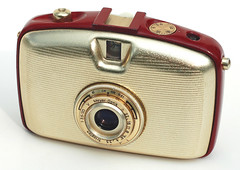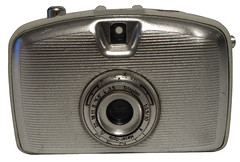Difference between revisions of "Penti"
Rebollo fr (talk | contribs) m (image rights) |
Hanskerensky (talk | contribs) (Added link to user manual page) |
||
| (26 intermediate revisions by 11 users not shown) | |||
| Line 1: | Line 1: | ||
| + | {|class=floatright | ||
| + | | | ||
{{Flickr image | {{Flickr image | ||
| − | | image_source=http://www.flickr.com/photos/kratz/ | + | | image_source=http://www.flickr.com/photos/kratz/2513374747/in/pool-camerawiki/ |
| − | | image=http:// | + | | image=http://farm4.static.flickr.com/3180/2513374747_7752245d96_m.jpg |
| − | | image_align= | + | | image_align=right |
| − | | image_text= | + | | image_text=Red Penti, showing<br>tip of advance plunger |
| + | | image_by= John Kratz | ||
| + | | image_rights= nc | ||
}} | }} | ||
| − | + | |- | |
| − | + | | | |
{{Flickr image | {{Flickr image | ||
| − | | image_source=http://www.flickr.com/photos/ | + | | image_source=http://www.flickr.com/photos/ricksoloway/2211485765/in/pool-camerawiki/ |
| − | | image=http:// | + | | image=http://farm3.staticflickr.com/2235/2211485765_7ec526cffb_m.jpg |
| image_align=right | | image_align=right | ||
| − | | image_text= | + | | image_text=Grey (?) Penti |
| + | | image_by= Rick Soloway | ||
| + | | image_rights= with permission | ||
}} | }} | ||
| − | + | |} | |
| + | |||
{{Flickr image | {{Flickr image | ||
| − | | image_source=http://www.flickr.com/photos/ | + | | image_source=http://www.flickr.com/photos/kratz/2241704075/in/pool-camerawiki/ |
| − | | image=http://farm3.static.flickr.com/ | + | | image=http://farm3.static.flickr.com/2262/2241704075_85bc5afcc1.jpg |
| − | | image_align= | + | | image_align=left |
| − | | image_text= | + | | image_text=Blue Penti with [[Meyer]] Trioplan 30mm f3.5 lens |
| + | | image_by= John Kratz | ||
| + | | image_rights= nc | ||
| + | }} | ||
| + | |||
| + | <br style="clear:left" /> | ||
| + | The '''Penti''' was made in East Germany by [[Welta]] from late 1950s. It was available with a white, red , black or blue body. | ||
| + | |||
| + | The camera was being developed by Walter Henning at [[Zeiss Ikon|VEB Zeiss Icon]] company from 1956 and went into production as '''Welta Orix''' in April 1958 at [[Welta|VEB Welta Kamera Werke]] factory (renamed to VEB Prüfgerätewerk Medingen in 1960), as its parent VEB Zeiss Ikon company lacked enough production capacity. The name Orix was however quickly changed to '''Penti''' - in approximately one year<ref>The name Penti is already used in Steiner J. (ed.): Foto Taschenbuch 1960; Fotokinoverlag, Halle (Saale), 1959, p. 235.</ref> and the production at Welta continued till the end of 1961.<ref> Jemlich G.: Der VEB Pentacon Dresden; Sandstein Verlag, 2009, <nowiki>ISBN 978-3-9403149-75-3</nowiki>; p. 100 </ref> In 1962 the production was transferred to Object 1 plant of the VEB Kamera- und Kinowerke Dresden (VEB KKWD, former [[Ica]] factory). A new version '''Penti II''' with exposure meter was developed there, eventually made from early 1960s to 1977<ref>Most web sites state, The Penti II was made already from 1961. According to Jemlich G.: Der VEB Pentacon Dresden; op. cit., p. 100 the Penti II was being developed by VEB KKWD from 1964 only and produced from 1965 – the camera is however illustrated in books published before 1965, e.g. Stapf H.: Fotografische Praxis; VEB Fotokinoverlag, Halle, 1963 or Wurst W.: Die Penti Schule; Fotokinoverlag, Leipzig, 1964. Jemlich also states, the name Penti was introduced in 1962 by the VEB KKWD only, what is also not true, as it appears in Foto Taschenbuch 1960, op. cit., published already in 1959.</ref> by the Object 10 factory in Helfenberg. A simpler variant of the Penti II (without metering), the '''Penti I''', was also made there, but discontinued before 1966.<ref>According to Brauer E.: Foto-Optik; VEB Fachbuchverlag, Leipzig, 1966 (edition closed on December 30, 1965), the Penti I was no longer made but still available in shops.</ref> Some 800 000 cameras were produced from 1959 to 1977.<ref>Jemlich G.: Der VEB Pentacon Dresden; op. cit., p. 100</ref> | ||
| + | |||
| + | Together with the camera, the [[Orwo|VEB Filmfabrik Agfa Wolfen]] renewed production of the pre-war [[Agfa Karat]] film, a fast loading 35 mm film standard, greatly simplifying camera maintenance. Agfa Karat used two equal cartridges, one loaded, the other empty. The [[film advance]] system shifted the film via the image plane from one cartridge into the other, image by image. From 1964, when name of the East German Agfa company was changed from Agfa to Orwo, the film type was renamed to Orwo Penti (Orwo-Penti-Patrone) and this name was being used till the late 1960s, when a new standard, [[SL System|Schnelladekassette]] (Speed Loading Cassette) was developed on the Penti cassette basis. | ||
| + | |||
| + | {{Flickr_image | ||
| + | |image_source= http://www.flickr.com/photos/126532323@N03/50443473008/in/pool-camerawiki/ | ||
| + | |image= http://farm5.staticflickr.com/65535/50443473008_54e6bff8e6_w.jpg | ||
| + | |image_align= right | ||
| + | |image_text= Penti in 5 different colours | ||
| + | |image_by= Jaap Schelvis | ||
| + | |image_rights= with permission | ||
}} | }} | ||
| − | |||
| − | |||
{{Flickr image | {{Flickr image | ||
| − | | image_source=http://www.flickr.com/photos/89864432@N00/245766133/in/pool- | + | | image_source=http://www.flickr.com/photos/89864432@N00/245766133/in/pool-camerawiki/ |
| image=http://farm1.static.flickr.com/94/245766133_ff00f9198b.jpg | | image=http://farm1.static.flickr.com/94/245766133_ff00f9198b.jpg | ||
| image_align=left | | image_align=left | ||
| − | | image_text=SL film cartridges and black Penti's camera back opened<br>showing advance button pushed in on the left. | + | | image_text=SL film cartridges and black Penti's camera back opened<br>showing advance button pushed in on the left. |
| − | + | | image_by=Uwe Kulick | |
| − | The '''Penti''' may have been the finest [[compact camera]] for | + | | image_rights= With permission |
| − | [[Vitessa|Voigtländer's Vitessa]] had a similar feature. | + | }} |
| + | |||
| + | |||
| + | <br style="clear:left" /> | ||
| + | The '''Penti''' may have been the finest [[compact camera]] for the later SL film load system. This was a viewfinder camera with a complete set of manual controls, all in rings around the lens: One for distance, one for aperture, and one for shutter speed. It could make 24 18×24mm exposures on one strip of 35mm film. There was a 1:3.5/30 lens, a Meyer [[Domiplan]] or a Meyer Trioplan, and a [[flash sync]]hronized [[leaf shutter]] (the synchronisation of the original Orix/Penti variant was adjusted for bulb flashes only!). | ||
| + | |||
| + | The Penti's most unusual feature was the long film advance button. Once pushed into the camera the film was advanced to the next frame. After exposure the button appeared again in full length so that forgetting film advance was never an issue with this camera. [[Vitessa|Voigtländer's Vitessa]] had a similar feature. | ||
| + | |||
| + | |||
{{Flickr image | {{Flickr image | ||
| − | | image_source=http://www.flickr.com/photos/89864432@N00/245758839/in/pool- | + | | image_source=http://www.flickr.com/photos/siimvahur/5686399035/in/pool-camerawiki/ |
| + | | image=http://farm6.static.flickr.com/5224/5686399035_5cd7a86a8f.jpg | ||
| + | | image_align=left | ||
| + | | image_text=Penti II - with meter, showing advance plunger | ||
| + | | image_by= Siim Vahur | ||
| + | | image_rights= With permission | ||
| + | }} | ||
| + | {{Flickr image | ||
| + | | image_source=http://www.flickr.com/photos/89864432@N00/245758839/in/pool-camerawiki/ | ||
| image=http://farm1.static.flickr.com/88/245758839_0b14beb04c.jpg | | image=http://farm1.static.flickr.com/88/245758839_0b14beb04c.jpg | ||
| image_align=left | | image_align=left | ||
| − | | image_text=Penti | + | | image_text=Penti I - in spite of its appearance,<br/>the camera has no exposure meter. |
| − | + | | image_by= Uwe Kulick | |
| − | + | | image_rights= With permission | |
| − | The '''Penti I''' was similar to the II, but without the meter. | + | }} |
| + | <br style="clear:left" /> | ||
| + | The ‘’’Penti II’’’ made it a real classic, combining the uniquely designed full featured viewfinder camera with viewfinder-controlled coupled match-needle [[selenium meter]]. {{br}} | ||
| + | The '''Penti I''' was similar to the Penti II, but without the meter. Both cameras are nearly identical externally - the Penti I still has fake "exposure meter" windows on both side of the viewfinder - so they can be easily confused. They can be however easily distinguished by "Penti I" and "PENTI II" names below the lens. Both the Penti I and II could synchronise a bulb flash at 1/30 s and an electronic flash at any shutter speed. | ||
| + | After the Penti I and II were introduced, the original Penti was sometimes called the '''Penti 0'''.<ref> Wurst W.: Die Penti Schule; Fotokinoverlag, Leipzig, 1964</ref> | ||
| + | {{Flickr_image | ||
| + | |image_source= http://www.flickr.com/photos/126532323@N03/51524665040/in/pool-camerawiki/ | ||
| + | |image= http://farm6.staticflickr.com/65535/51524665040_84311652bc_z.jpg | ||
| + | |image_align= left | ||
| + | |image_text= Penti I (1963) export version with leatherette covering | ||
| + | |image_by= Jaap Schelvis | ||
| + | |image_rights= with permission | ||
| + | }} | ||
| + | |||
| + | {{br}} | ||
| + | ==Notes== | ||
| + | <references/> | ||
==Links== | ==Links== | ||
| − | *[ | + | *[https://www.butkus.org/chinon/welta/welta_penti_i/welta_penti_i.htm Penti I user manual (in German)] at [https://www.butkus.org/chinon/ Butkus.org] |
| − | + | *[https://www.butkus.org/chinon/pentacon/pentacon_penti_ii/pentacon_penti_ii.htm Penti II user manual (in German)] at [https://www.butkus.org/chinon/ Butkus.org] | |
| − | *[http://www.optiksammlung.de/Diverse/PentaconPentiII.html Penti II] at | + | *[http://www.kameramuseum.de/0-fotokameras/ddr/welta/penti.html Welta Penti] and [http://www.kameramuseum.de/0-fotokameras/ddr/welta/penti-2-sw.html Penti II] at [http://www.kameramuseum.de Kurt Tauber's] |
| + | *[http://www.optiksammlung.de/Diverse/PentaconPentiII.html Penti II] at [http://www.optiksammlung.de Optiksammlung] | ||
* [http://corsopolaris.net/supercameras/half/halformat1s.html Half Format Cameras 135] on [http://corsopolaris.net/supercameras/ Massimo Bertacchi's Innovative Cameras page] has all three Pentis | * [http://corsopolaris.net/supercameras/half/halformat1s.html Half Format Cameras 135] on [http://corsopolaris.net/supercameras/ Massimo Bertacchi's Innovative Cameras page] has all three Pentis | ||
| + | * [http://www.collection-appareils.fr/x/html/page_standard.php?id_appareil=10047 Penti], [http://www.collection-appareils.fr/x/html/page_standard.php?id_appareil=970 Penti II] on [http://www.collection-appareils.fr/general/html/francais.php www.collection-appareils.fr] by Sylvain Halgand (in French) | ||
| + | * [https://web.archive.org/web/20150404020402/http://www.sovietcamera.fr/penti.htm Penti 2] on JM Burtscher [https://web.archive.org/web/20150321204730/http://www.sovietcamera.fr/index.html Sovietcamera french website] (archived) | ||
| + | |||
| + | |||
{{compact classic}} | {{compact classic}} | ||
Latest revision as of 06:47, 4 October 2021
| ||
|
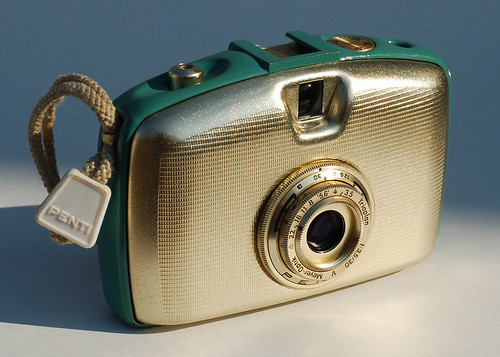
|
| Blue Penti with Meyer Trioplan 30mm f3.5 lens image by John Kratz (Image rights) |
The Penti was made in East Germany by Welta from late 1950s. It was available with a white, red , black or blue body.
The camera was being developed by Walter Henning at VEB Zeiss Icon company from 1956 and went into production as Welta Orix in April 1958 at VEB Welta Kamera Werke factory (renamed to VEB Prüfgerätewerk Medingen in 1960), as its parent VEB Zeiss Ikon company lacked enough production capacity. The name Orix was however quickly changed to Penti - in approximately one year[1] and the production at Welta continued till the end of 1961.[2] In 1962 the production was transferred to Object 1 plant of the VEB Kamera- und Kinowerke Dresden (VEB KKWD, former Ica factory). A new version Penti II with exposure meter was developed there, eventually made from early 1960s to 1977[3] by the Object 10 factory in Helfenberg. A simpler variant of the Penti II (without metering), the Penti I, was also made there, but discontinued before 1966.[4] Some 800 000 cameras were produced from 1959 to 1977.[5]
Together with the camera, the VEB Filmfabrik Agfa Wolfen renewed production of the pre-war Agfa Karat film, a fast loading 35 mm film standard, greatly simplifying camera maintenance. Agfa Karat used two equal cartridges, one loaded, the other empty. The film advance system shifted the film via the image plane from one cartridge into the other, image by image. From 1964, when name of the East German Agfa company was changed from Agfa to Orwo, the film type was renamed to Orwo Penti (Orwo-Penti-Patrone) and this name was being used till the late 1960s, when a new standard, Schnelladekassette (Speed Loading Cassette) was developed on the Penti cassette basis.

|
| Penti in 5 different colours image by Jaap Schelvis (Image rights) |
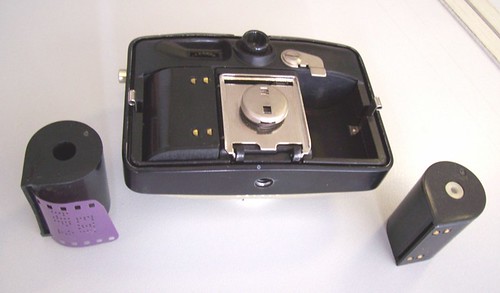
|
| SL film cartridges and black Penti's camera back opened showing advance button pushed in on the left. image by Uwe Kulick (Image rights) |
The Penti may have been the finest compact camera for the later SL film load system. This was a viewfinder camera with a complete set of manual controls, all in rings around the lens: One for distance, one for aperture, and one for shutter speed. It could make 24 18×24mm exposures on one strip of 35mm film. There was a 1:3.5/30 lens, a Meyer Domiplan or a Meyer Trioplan, and a flash synchronized leaf shutter (the synchronisation of the original Orix/Penti variant was adjusted for bulb flashes only!).
The Penti's most unusual feature was the long film advance button. Once pushed into the camera the film was advanced to the next frame. After exposure the button appeared again in full length so that forgetting film advance was never an issue with this camera. Voigtländer's Vitessa had a similar feature.
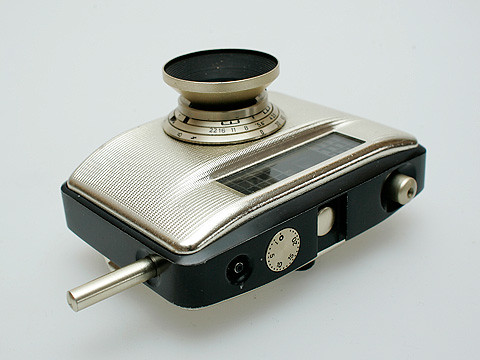
|
| Penti II - with meter, showing advance plunger image by Siim Vahur (Image rights) |

|
| Penti I - in spite of its appearance, the camera has no exposure meter. image by Uwe Kulick (Image rights) |
The ‘’’Penti II’’’ made it a real classic, combining the uniquely designed full featured viewfinder camera with viewfinder-controlled coupled match-needle selenium meter.
The Penti I was similar to the Penti II, but without the meter. Both cameras are nearly identical externally - the Penti I still has fake "exposure meter" windows on both side of the viewfinder - so they can be easily confused. They can be however easily distinguished by "Penti I" and "PENTI II" names below the lens. Both the Penti I and II could synchronise a bulb flash at 1/30 s and an electronic flash at any shutter speed.
After the Penti I and II were introduced, the original Penti was sometimes called the Penti 0.[6]
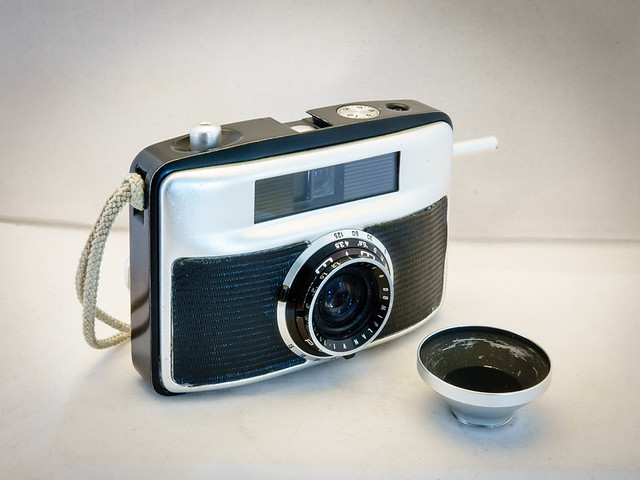
|
| Penti I (1963) export version with leatherette covering image by Jaap Schelvis (Image rights) |
Notes
- ↑ The name Penti is already used in Steiner J. (ed.): Foto Taschenbuch 1960; Fotokinoverlag, Halle (Saale), 1959, p. 235.
- ↑ Jemlich G.: Der VEB Pentacon Dresden; Sandstein Verlag, 2009, ISBN 978-3-9403149-75-3; p. 100
- ↑ Most web sites state, The Penti II was made already from 1961. According to Jemlich G.: Der VEB Pentacon Dresden; op. cit., p. 100 the Penti II was being developed by VEB KKWD from 1964 only and produced from 1965 – the camera is however illustrated in books published before 1965, e.g. Stapf H.: Fotografische Praxis; VEB Fotokinoverlag, Halle, 1963 or Wurst W.: Die Penti Schule; Fotokinoverlag, Leipzig, 1964. Jemlich also states, the name Penti was introduced in 1962 by the VEB KKWD only, what is also not true, as it appears in Foto Taschenbuch 1960, op. cit., published already in 1959.
- ↑ According to Brauer E.: Foto-Optik; VEB Fachbuchverlag, Leipzig, 1966 (edition closed on December 30, 1965), the Penti I was no longer made but still available in shops.
- ↑ Jemlich G.: Der VEB Pentacon Dresden; op. cit., p. 100
- ↑ Wurst W.: Die Penti Schule; Fotokinoverlag, Leipzig, 1964
Links
- Penti I user manual (in German) at Butkus.org
- Penti II user manual (in German) at Butkus.org
- Welta Penti and Penti II at Kurt Tauber's
- Penti II at Optiksammlung
- Half Format Cameras 135 on Massimo Bertacchi's Innovative Cameras page has all three Pentis
- Penti, Penti II on www.collection-appareils.fr by Sylvain Halgand (in French)
- Penti 2 on JM Burtscher Sovietcamera french website (archived)
| Classic Compact Cameras |
|---|
| Canon IXUS | Minox 35 | Olympus XA | Penti |
